When a trove of antique German stoneware seltzer bottles was found underground behind 1425 Paru Street this summer (see Part 1), that discovery set in motion a quest to learn more about the history of the house, and why these items would be found there.
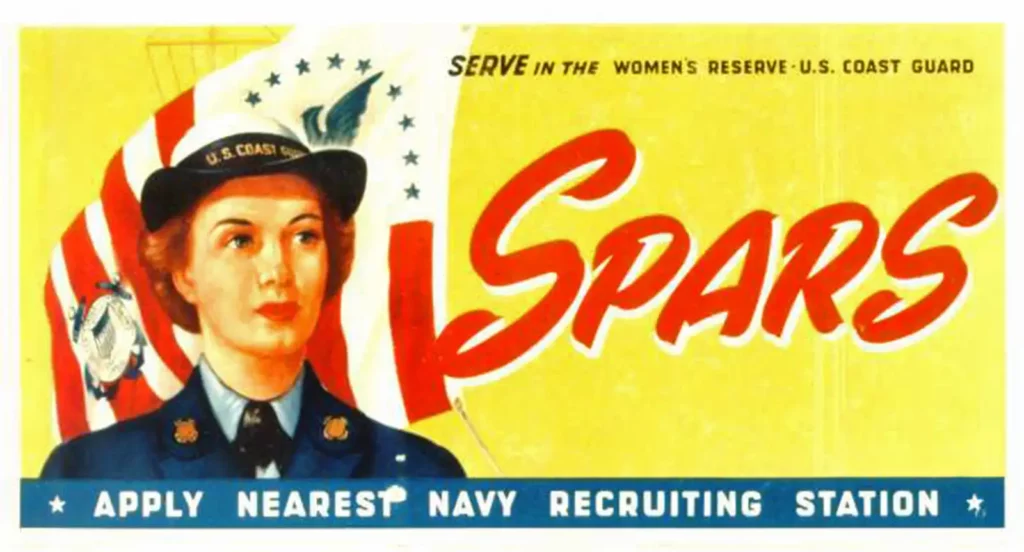
Family history
Built in 1913, the home is a Craftsman style bungalow, purchased by Mabel and Ralph Thompson in 1917. They had one daughter, Kathleen, who was born in 1915. Ralph Lattimore Thomson (1881-1959) had immigrated to the United States from White House Townland, County Antrim, Ireland in 1907. Mabel Harriet Melrose Thomson (1894-1992) hailed from Sprague, Washington. They raised their only child, Kathleen, in this house, and proudly attended her graduation from UC Berkeley in 1937.
SPARS
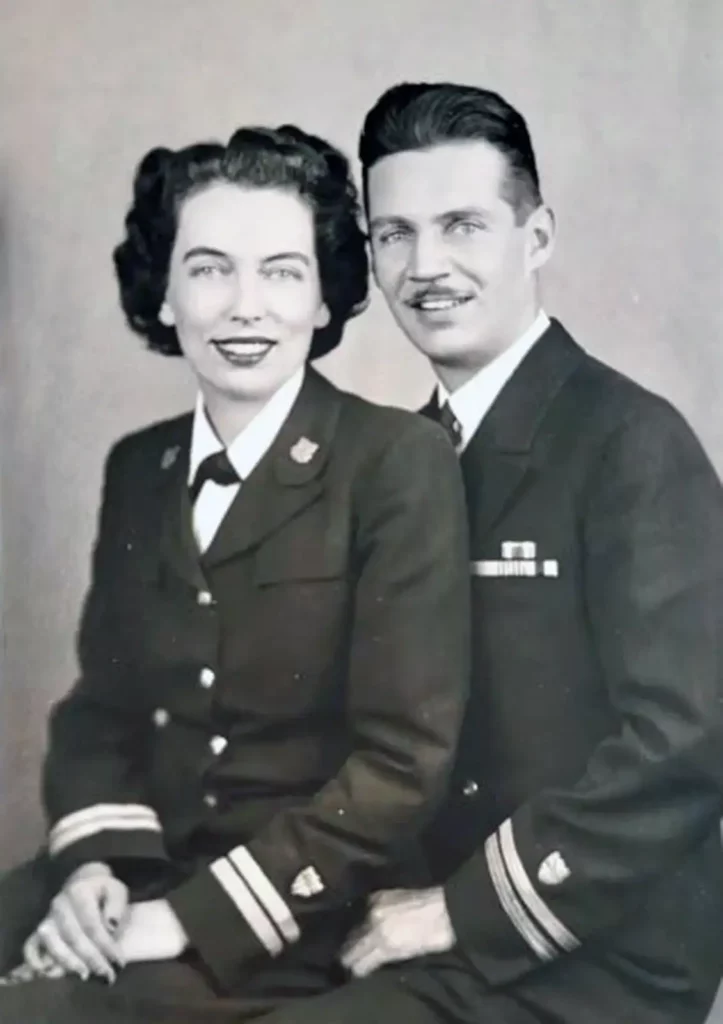
When World War II broke out, Kathleen Thomson enlisted in the Women’s Reserve of the United States Coast Guard, also known as SPARS. According to the Pritzker Military Museum in Chicago, “To supplement Coast Guard personnel, the SPARS were formed in November of 1942. The acronym comes from a combination of the Guard’s Latin motto ‘Semper Paratus’ and the English translation, ‘Always Ready.’ The SPARS’ roles in the Coast Guard were limited to shore duties in lighthouses, harbors, and bases. At first, SPARS were confined to the continental United States, but like the WAVES, in 1944, they were allowed to serve in the territories of Hawaii and Alaska.”
Kathleen Thomson rose to the rank of Chief Morale Officer, and after the war she met a fellow Coast Guard officer, Frederick G. Stoye, whom she would go on to marry at the First Presbyterian Church in Alameda. Kathleen and Fred started a family, and in 1953 moved to Moab, Utah, during the emerging uranium boom.
Meanwhile, back in Alameda
As the Stoyes settled into Moab, Kathleen’s parents, the Thompsons, remained happily living in Alameda. The Stoyes had four children, and the family loved driving to California every year on vacation to visit with their Nana and Granddaddy on Paru Street.
Granddaughter Rita Hampson shared these memories: “The Alameda house was filled with music, friends, and art. Nana took up art seriously after my mother grew up. She commissioned many paintings, especially portraits around the Alameda area. She did many still life oil paintings which we have saved and cherish. She studied and took classes with good, well-known artists in the area. Later, she gave painting lessons herself in her home. We remember her painting when she visited us in Moab, Utah. Some portraits, and some mountain scenery. We visited our grandparents every year on vacation. We have fond memories of those visits… the drawer full of games, the wonderful sleeping porch where we slept in beds next to them, listening to the fog horns and enjoying the screened in area. Good times!”

Life’s changes
Granddaddy Ralph Lattimore Thomson died in 1959, and Nana Mabel Thomson remained living alone in the Paru Street house. She got even more involved in her art, and an October 1960 article in the Alameda Times Star reported on her art exhibition at the Hotel Alameda. She maintained a fulfilling life for herself by staying involved in her church, her art, and her family. Mabel was also a member of the Adelphian Club and the Alameda Art Association.
In Moab, the Stoye children grew up, and then eventually had to say goodbye to their dear father Fred G. Stoye, who passed away in 1986. Fred, a U. S. Coast Guard veteran, had enjoyed a career that included serving as manager and president of a radio station.
Rita described what happened next: “Then when Dad died in 1986, Mom and Nana lived together and spent half their time in Alameda and half in Moab. (Thanksgiving and winters in Alameda, and summers in Moab. Mom and Nana had friends and close cousins in Walnut Creek.) After Nana passed, Mom kept driving the trip twice a year until into her late 90s. My nephew, Abram, was caretaker of the Paru house after Mom couldn’t go back and forth anymore. Mom died in Moab at 107, two months before her 108th birthday. Nana died in 1992 at 98 years young. Mom and Nana were both avid bridge players in Moab and Alameda. They wouldn’t want you to miss that!”
A long life and a discovery
Kathleen Thomson Stoye lived a long and interesting life. Starting out in a bungalow on Paru Street, she went on to graduate from UC Berkeley at a time when college degrees weren’t as common for women. She became one of the first female officers in the U.S. Coast Guard, raised four children, and lived to the extraordinary age of 107. She attributed her longevity to keeping a positive attitude, playing bridge, and enjoying a glass of wine every day. Kathleen Thomson’s passing in February 2023 led to the discovery of a trove of antique stoneware vessels that had lain hidden in the earth behind 1425 Paru Street for her entire life, as well as the lives of her parents.
After 106 years of Thomson family ownership, it was time to spruce the old house up for sale. This work included landscaping and other work in the backyard near the house, at which time around 14 or more antique stoneware vessels stamped with German writing were found underground. In Part 1 of this story, we described the research that determined the origin of these bottles, which once held naturally carbonated spring water from the Niederselters region of Germany. But why was such a trove buried behind a house on Paru Street?
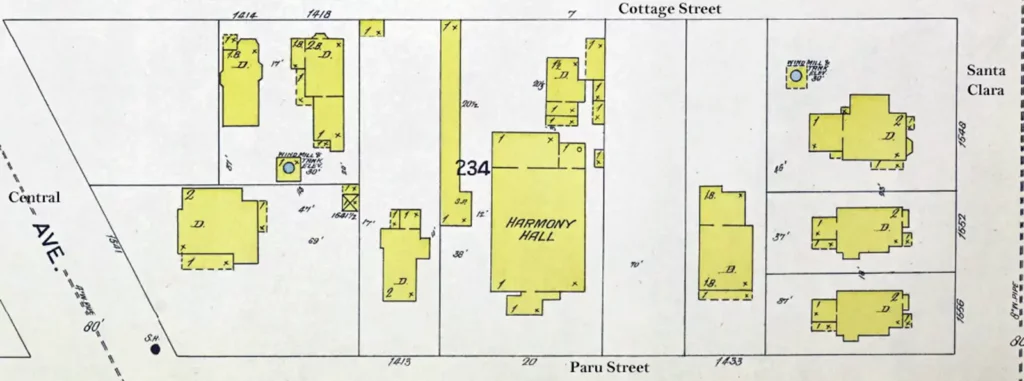
Harmonie Hall
A clue can be found by looking at an 1897 Sanborn Fire Map of this block, which shows that something called Harmony Hall (more commonly spelled Harmonie Hall) once stood on this spot. The property was so large that it encompassed not only today’s 1425 Paru Street and its neighbor 1415 Paru Street, but also three houses on the opposite block—1428, 1430, and 1438 Cottage Street.
Harmonie Hall was a German-American social hall built in the late 1870s by a group of neighbors. It was situated at a choice location near the train line that once ran along Lincoln Avenue, with the station at Fassking’s Gardens (at Grand Street and Lincoln Avenue). Among the founders of Harmonie Hall was Alfred A. Baroteau, who was involved in an early resort at Grand Street and Lincoln Avenue called Central Gardens. Advertisements for Harmonie Hall don’t list a specific address, instead just describing it as being located “west side Paru, bet. Santa Clara and Central Aves.”
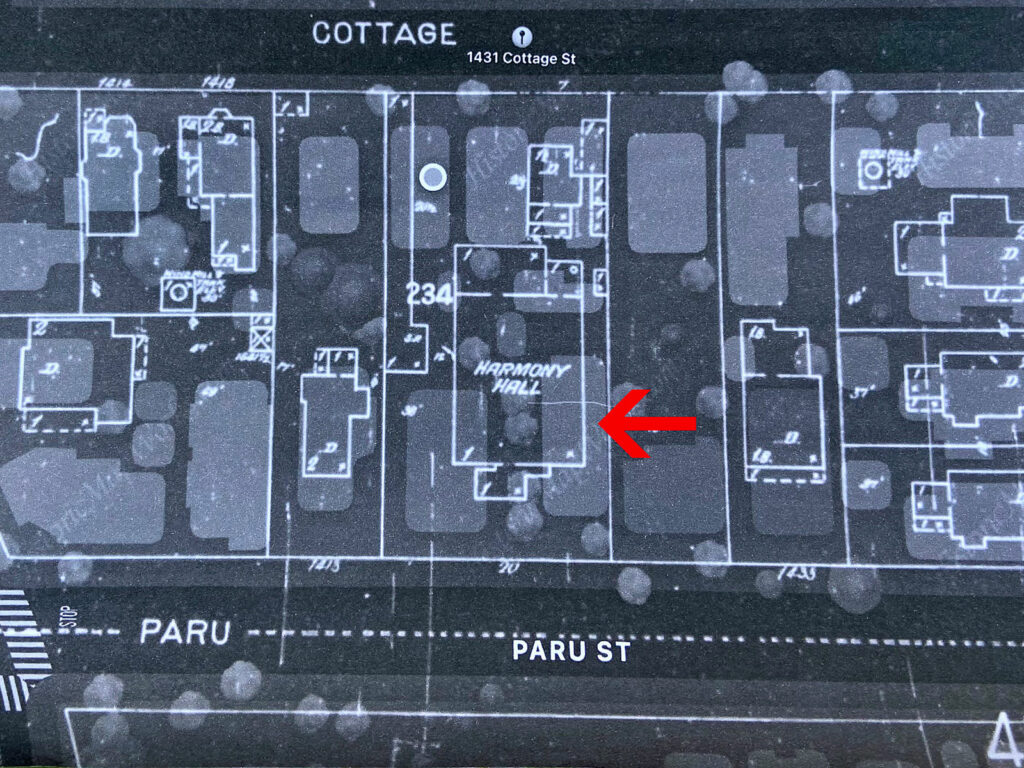
The manager of Harmonie Hall was Felix Wirbser, who was born in 1852 in Germany. Newspaper advertisements from the time promoted the Hall with the promise of “Suppers, dinners and refreshments furnished, on short notice, in first-class style. For weddings, balls, entertainments, etc.” Other events that took place at Harmonie Hall included concerts, dance classes, and political meetings. Many local organizations held meetings and festivities there, and by early 1911 the hall was considered one of Alameda’s oldest dancing pavilions and social centers. Paru Street is a quiet residential lane now, but for more than 30 years the block between Central and Santa Clara Avenues was the site of much activity and merriment, as Harmonie Hall enjoyed its heyday.
A mystery solved
The discovery of this trove of stoneware seltzer water bottles from Niederselters, Germany, on the site of the long-forgotten Harmonie Hall is a tangible reminder that remnants of the past still lie below our feet, just waiting to be discovered. Since the Harmonie Hall plot encompassed land that today spans five separate properties, extending from Paru Street to Cottage Street, one can only imagine how many more historical artifacts from that period still remain hidden below the ground in this area. But for now, these newly unearthed antique vessels are an important part of Alameda history, and are the only known remnants of the once popular Harmonie Hall. While we may not know what Harmonie Hall looked like, we now know that they drank Niederselters water at this establishment, poured from stoneware bottles.
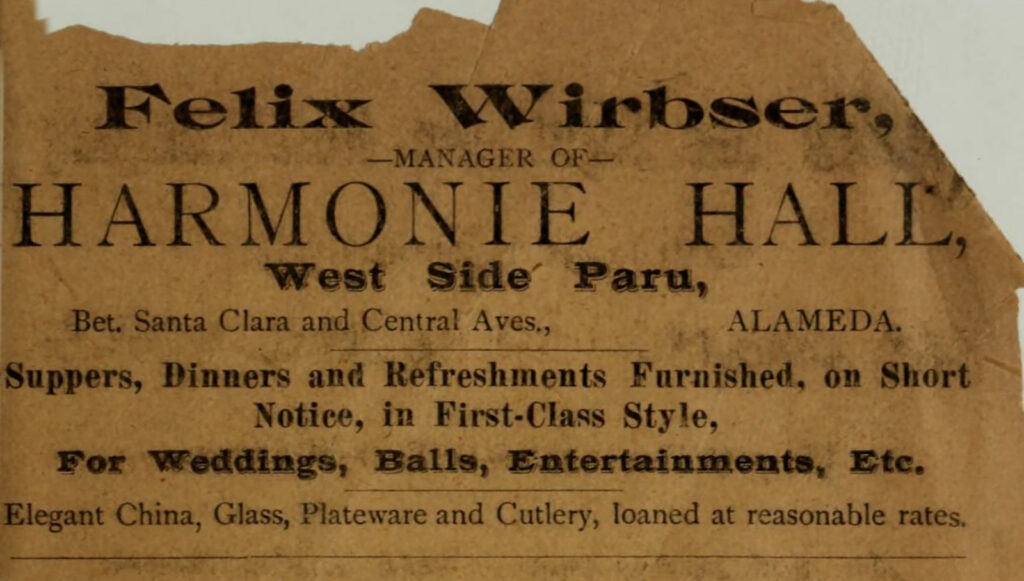
Next up
Why did the thriving Harmonie Hall cease to exist by the end of 1911, and get replaced by the Craftsman style bungalows that have stood there since 1913? In our next chapter, we’ll look into what happened to the hall, and how that set the stage for the Thomson family to buy a house at 1425 Paru Street, leading to Kathleen Thomson growing up there, serving in the Coast Guard, raising a family, living to 107, and then, in death, prompting the discovery of the stoneware vessels that connect us back over 140 years to the origins of the property. It’s all connected, as we explore our Alameda Treasures, 1425 Paru Street and Harmonie Hall.
Contributing writer Steve Gorman has been a resident of Alameda since 2000, when he fell in love with the history and architecture of this unique town. Contact him via [email protected]. His writing is collected at AlamedaPost.com/Steve-Gorman.



